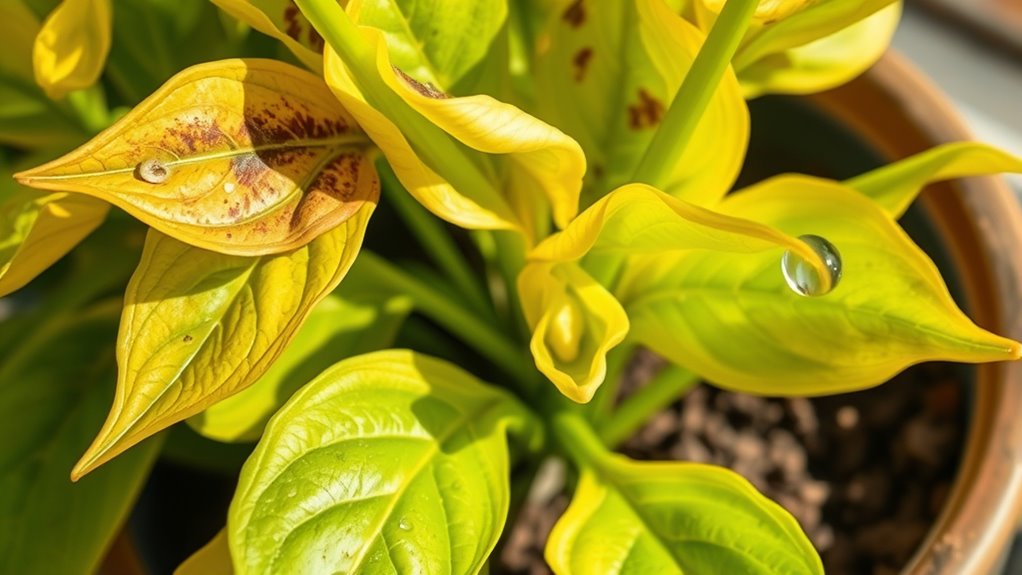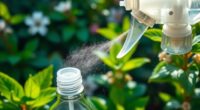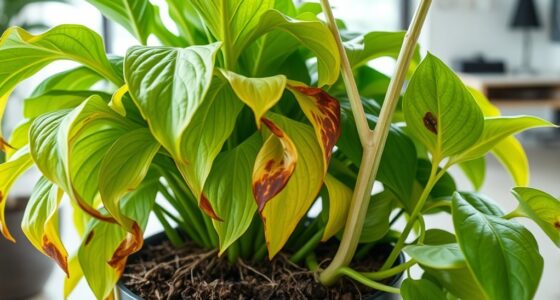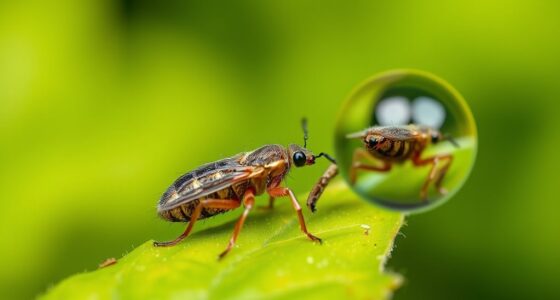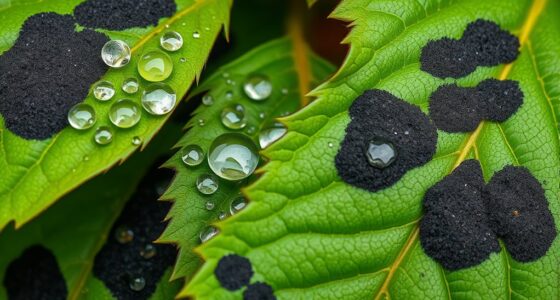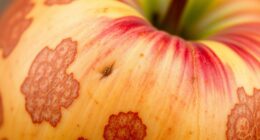If your plant shows yellowing leaves, it might be over or underwatered. Wilting, crispy edges, or leaf drop can also indicate watering issues or environmental stress. Look for pests like tiny bugs, webbing, or sticky residue, which signal infestations. Poor lighting, drafts, or temperature shifts can cause leaf discoloration or dropping. Spotting spots, mold, or unusual growth points to disease. Identifying these signs early helps, so stay alert—more tips await to help your plant thrive.
Key Takeaways
- Observe leaf color and texture for signs of overwatering, underwatering, pests, or disease.
- Check soil moisture regularly to distinguish between dry or soggy soil issues.
- Look for pests, webbing, sticky residue, or deformed leaves as indicators of infestation.
- Assess environmental conditions like light, drafts, and temperature for stress-related problems.
- Monitor overall plant vigor, noting any leaf curling, spotting, or yellowing to identify specific concerns.
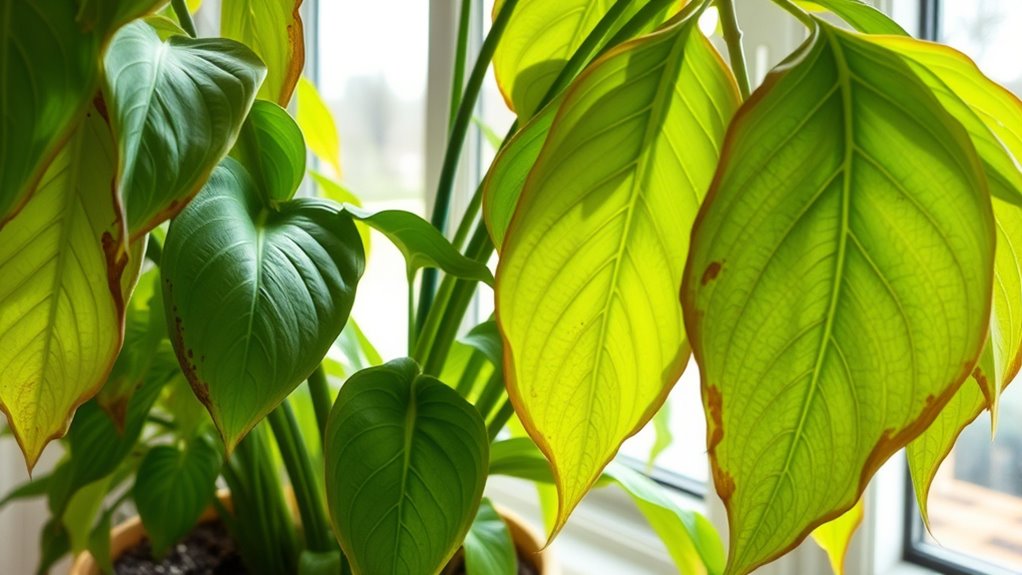
When your plants start showing signs of stress, identifying the problem early can make all the difference. One of the most common issues you’ll encounter involves watering problems. Overwatering can lead to root rot, causing leaves to turn yellow, wilt, or drop prematurely. Conversely, underwatering results in dry, crispy edges, drooping stems, and a general lack of vigor. To troubleshoot, check the soil moisture—stick your finger about an inch deep. If it’s soggy, you’re likely watering too much; if it’s bone dry, your plant needs more water. Adjust your watering schedule accordingly, ensuring you’re providing consistent moisture without drowning the roots. Remember, different plants have varied needs, so research your specific species for suitable watering practices. Proper hydration is crucial for maintaining healthy plant tissue and preventing common issues like leaf curling or spotting.
Pest identification is another essential step in diagnosing plant problems. Tiny pests like spider mites, aphids, or mealybugs can wreak havoc, often hiding on the undersides of leaves or within leaf folds. Look for telltale signs such as sticky residue, webbing, or deformed leaves. If you spot pests, act quickly with targeted treatments—either insecticidal soap, neem oil, or manually removing them. Regular inspection helps catch infestations early before they spread extensively. Pest damage often mimics other issues like nutrient deficiencies or disease, so close examination is critical. Recognizing pests early allows you to prevent severe damage, preserve your plant’s health, and avoid using harsh chemicals that could harm beneficial insects or your plant.
Beyond watering and pests, you should also pay attention to your plant’s environment. Poor lighting, for example, can cause etiolation—stretching and pale leaves—while drafts or sudden temperature changes stress the plant, leading to leaf drop or slowed growth. If you notice your plant’s leaves yellowing without signs of pests or watering issues, consider adjusting its location. Ensuring proper light, humidity, and air circulation can markedly improve your plant’s resilience. Additionally, inspect for signs of disease, such as spots, mold, or unusual growths, which might require specific treatments.
Being aware of lighting conditions and maintaining a stable environment can significantly reduce the likelihood of stress-related problems. Ultimately, diagnosing plant problems involves a keen eye and a methodical approach. Start by observing your plant’s overall appearance and behavior, then consider watering habits and inspect for pests. By doing so, you can quickly identify the root cause and take appropriate action, helping your plant recover and thrive. Remember, most plants are resilient if given proper care, and early detection is key to overcoming common issues.
Frequently Asked Questions
How Often Should I Water My Specific Plant Species?
To determine your plant’s watering schedule, you need to check soil moisture regularly. Most plants prefer the soil to dry out slightly between waterings, so avoid overwatering. Typically, you should water when the top inch of soil feels dry. Adjust frequency based on your plant’s specific needs and environment, like humidity and light. Remember, consistent soil moisture helps keep your plant healthy and happy.
What Is the Ideal Sunlight for My Indoor Plant?
Imagine your indoor plant basking in gentle sunlight, its leaves glowing with health. You should provide it with bright, indirect light, mimicking its preferred sun exposure. Most indoor plants thrive with 6-8 hours of filtered sunlight daily. Adjust the placement near windows with sheer curtains or in well-lit spots. Understanding your plant’s light requirements helps it flourish, ensuring vibrant growth and lush foliage.
How Can I Prevent Pests From Infesting My Plants?
To prevent pests from infesting your plants, focus on pest prevention and maintaining good plant hygiene. Regularly inspect your plants for early signs of pests and keep leaves clean by gently washing them. Remove dead or decaying plant material promptly, and avoid overwatering, which attracts pests. Using natural repellents and isolating new plants can also help. Staying vigilant and practicing these habits keeps pests at bay and promotes healthy growth.
When Should I Repot My Plant for Healthy Growth?
You might think repotting is a hassle, but it’s key for your plant’s health. Follow a regular repotting schedule, usually every 1-2 years, or when roots outgrow the pot. Check root health—if roots are circling or growing out of drainage holes, it’s time to move up to a bigger container. Repotting refreshes soil nutrients and prevents rootbound issues, keeping your plant happy and thriving.
Which Fertilizers Are Safest for My Plant Type?
When choosing fertilizers, you should consider your plant’s specific needs and whether organic or synthetic options are better. Organic fertilizers tend to have lower fertilizer toxicity and release nutrients slowly, reducing risk of overfeeding. Synthetic fertilizers often provide quick results but can pose higher risks of fertilizer toxicity if misused. Always follow label instructions and research your plant’s requirements to guarantee safe, healthy growth without harming your plant.
Conclusion
So there you have it—your plant’s little rebellion, all laid out. With these signs, you’re basically a plant whisperer in training, ready to tame those green divas. Just remember, neglect and overwatering are the real villains here. Next time your plant throws a tantrum, don’t panic—just diagnose, fix, and maybe offer a tiny apology for your past plant sins. After all, even plants deserve a little TLC, right?
